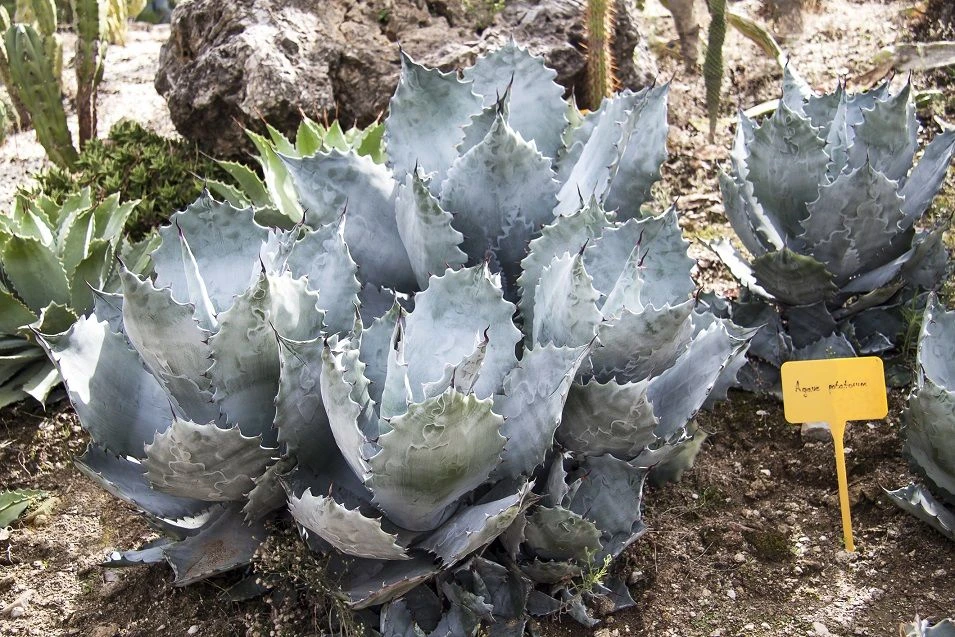reviewed by Truman Perkins
A succulent with a strange-sounding name, Agave potatorum is also known as the Butterfly Agave. As is the case with most Agave family members, Agave potatorum is a desert plant and a native of Mexico. Potatorum is the species' name and has nothing to do with the potato plant but rather stems from the plant's use in brewing beer. Potatorum is pronounced with the accent on the third syllable, i.e., pot-ta-TOH-rum. At times, one will come across the name Agave vershaffeltii, a variety of Agave potatorum.
Agave plants are related to the lily family but are more closely related to the Yucca. Most Agave plants bloom only once during their life. They form the shape of a rosette, with the succulent leaves emerging from a center stem. There are 200 species of Agave in the neighborhood, ranging from Venezuela, throughout the Caribbean area, Mexico, and the southern United States, where slightly more than a dozen different species may be found.
Should you ever be in the vicinity, one of the better places to view and be able to identify the different Agave species, including Agave potatorum, is the Desert Botanical Garden in Phoenix, Arizona. This excellent facility has samples from most of the desert plants found in and around the American Southwest.

Agave potatorum is a medium-sized agave, its rosette shape growing to about 2 feet high by 3 feet wide. The plant leaves vary in length from 10″ to 18″ and are broad and gray to steel blue. The Agave potatorum usually lives about ten years. Near the end of its life, it sends up a flower-bearing spike that can be anywhere from 10 to 20 feet high. The flowers are light green, in some cases more yellowish in color, and tinged with red. Once-blooming has ended, the entire plant will die. This plant is usually propagated from seed. If you wish to use your plant's roots, which should work perfectly fine, you can, but may have a long wait.
Insofar as pests and diseases are concerned, the greatest threats to the Agave potatorum are the snout weevil, mites, and crown rot, which can be dealt with by applications of insecticides, miticides, and fungicides, respectively. All three infestations are capable of eventually killing an established plant through tissue damage. Culture - As it grows in somewhat higher elevations, upwards to 7,000 feet, this plant is slightly frost hardy and can survive in temperatures that dip to 6 or 7 degrees below freezing. As expected with a desert plant, Agave potatorum likes full sun and does not require a great deal of water, being able to store the liquid in its leaves for extended periods. This plant is not particularly fussy about what kind of soil it should be placed in, only that the soil be well-drained.
One mistake gardeners sometimes make when transplanting an agave is to plant it more profound than initially planted. When this happens, the plant will usually not survive. The plant does require watering when first transplanted, with drip irrigation being the method of choice by many. Once established, the plant only needs to be rinsed occasionally, unless Mother Nature lends a hand. Young plants, intended for use in transplanting later on, are often grown in the filtered sun instead of direct sunlight. The plants will benefit from applying all-purpose fertilizer, such as 20-20-20, during its spring and fall growing seasons.
Agave potatorum is an excellent plant for a medium-sized container, and as such, is low maintenance, an easy plant to care for.
 |
 |
 |
 |

About Truman Perkins
Truman Perkins is a Detroit-based SEO consultant who's been in the business for over a decade. He got his start helping friends and clients get their websites off the ground, and he continues to do so today. In his free time, Truman enjoys learning and writing about gardening - something he believes is a natural stress reliever. He lives with his wife, Jenny, and their twins in Detroit.
 |
 |
 |
 |
Get new FREE Gifts. Or latest free growing e-books from our latest works.
Disable Ad block to reveal all the links. Once done, hit a button below
 |
 |
 |
 |